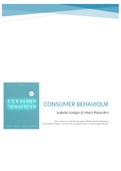CONSUMER BEHAVIOUR
Isabelle Szmigin & Maria Piacentini
This summary is made for the subject OE104 Customer Behaviour
and includes Chapter 1,2,3,4,5,6,7,8, 10 page 419-436, 11 and 12 page 508-514.
, PART 1 PERSPECTIVES ON CONSUMPTION
Chapter 1 A Context for Understanding Consumption
Consumption: individuals or groups acquiring, using and disposing of products, services, ideas or
experiences.
How consumption became a part of everyday life
In order to buy, consumers have to see value in the goods and services so that they are prepared to
exchange money for them. The growth of trade, and more latterly globalization, has been a key
element in the development of consumption. Spices were one of the earlies traded goods and were
highly valuable. As trade developed, new products became widely available. Today, while global
trade is the norm, people are increasingly aware of the impact of climate change from buying
globally sources items, in response retailers are sourcing food products from local suppliers, which
can simplify their supply chains and transportation costs. While some people today are accused of
excessive, wasteful, or conspicuous consumption, others are concerned about ethical consumption
and the impact that their behaviour has on the environment and on people living in socio-politically
oppressive regimes. Throughout the history of consumption, we see this juxtaposition of conspicuous
or inappropriate consumption against more considered or thoughtful ways to consume.
Stages of consumption history:
1. Subsistence level consumption
2. Sharing and bartering
3. Exchanging goods for money
4. Commercialization of goods, buying from shops etc.
5. Growth of trade across borders, leading to globalization
6. Mobile and Social E-commerce
As shops appeared, shopping became a pleasurable experience, and this led to increased investment
in production as manufacturers recognized that people were prepared to spend more on goods
above their needs.
Conspicuous consumption
The rise of consumption was mainly linked to the functional benefits consumption brought to
people’s lives. However, it was increasingly apparent that consumption brought social recognition to
people too.
Conspicuous consumption: the purchasing of luxury items to publicly display wealth to enhance
identity and/or prestige.
Today we are encouraged not to be wasteful, and the waste that consumer society produces has
itself caused huge problems in landfill sites and in the environment.
Shopping: from service to self-service
There were significant shifts in how consumer came to have access to goods, which also impacts on
consumption patterns and behaviour.
- Department stores > where consumers could visit to buy products while being assisted.
- Catalogue shopping > a population that is unable to get to the department stores, could go
through the catalogues and the department store could be brought directly into their
customers’ home.






